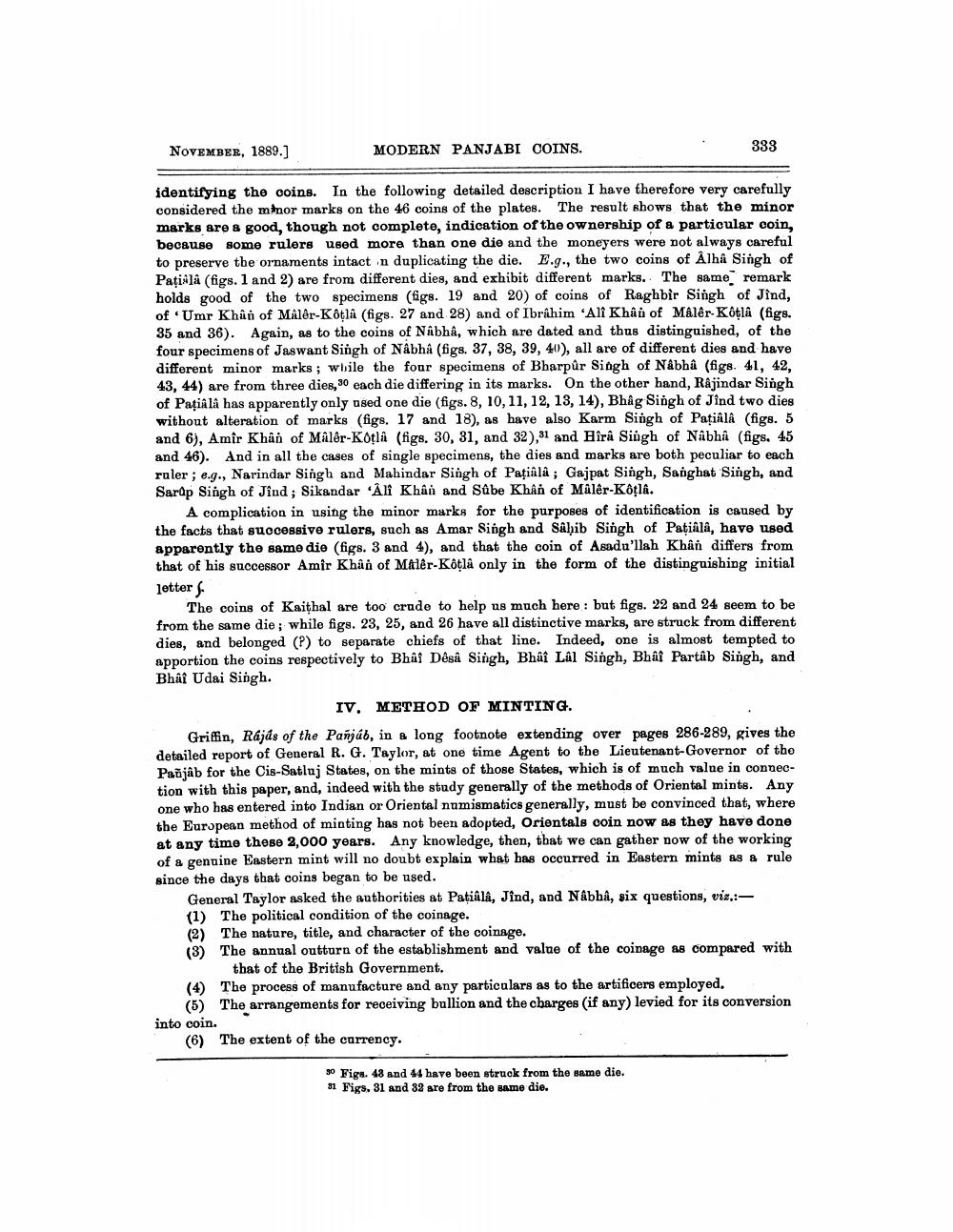________________
NOVEMBER, 1889.]
MODERN PANJABI COINS.
333
identifying the coins. In the following detailed description I have therefore very carefully considered the minor marks on the 46 coins of the plates. The result shows that the minor marks are a good, though not complete, indication of the ownership of a particular coin, because some rulers used more than one die and the moneyers were not always careful to preserve the ornaments intact in duplicating the die. E.g., the two coins of Âlha Singh of Patišla (figs. 1 and 2) are from different dies, and exhibit different marks. The same remark holds good of the two specimens (figs. 19 and 20) of coins of Raghbir Singh of Jind, of Umr Khân of Malêr-Kötla (figs. 27 and 28) and of Ibrahim Ali Khâů of Malêr-Kotlâ (figs. 35 and 36). Again, as to the coins of Nâbhâ, which are dated and thus distinguished, of the four specimens of Jaswant Singh of Nâbhâ (figs. 37, 38, 39, 40), all are of different dies and have different minor marks; wbile the four specimens of Bharpúr Singh of Nabha (fige. 41, 42, 43, 44) are from three dies, 30 each die differing in its marks. On the other hand, Rajindar Singh of Pația là has apparently only used one die (figs. 8, 10, 11, 12, 13, 14), Bhåg Singh of Jind two dies without alteration of marks (figs. 17 and 18), as have also Karm Singh of Pațiâlâ (figg. 5 and 6), Amir Khân of Malêr-KOțlâ (figs. 30, 31, and 32)," and Hira Singh of Nabhi (figs. 45 and 46). And in all the cases of single specimens, the dies and marks are both peculiar to each ruler; e.g., Narindar Singh and Mahindar Singh of Pațiâlâ ; Gajpat Singh, Sanghat Singh, and Sarap Singh of Jind; Sikandar Ali Khan and Sûbe Khan of Malêr-Kóla.
A complication in using the minor marks for the purposes of identification is caused by the facts that successive rulers, such as Amar Singh and Sahib Singh of Patiâlâ, have used apparently the same die (figs. 3 and 4), and that the coin of Asadu'llah Khân differs from that of his successor Amir Khân of Malêr-Kôțlà only in the form of the distinguishing initial letters
The coins of Kaithal are too crude to help us much here : but figs. 22 and 24 seem to be from the same die; while figs. 23, 25, and 26 have all distinctive marks, are struck from different dies, and belonged (?) to separate chiefs of that line. Indeed, one is almost tempted to apportion the coins respectively to Bhai Dêså Singh, Bhai Lal Singh, Bhai Partâb Singh, and Bhai Udai Singh.
IV. METHOD OF MINTING.
Griffin, Rájds of the Pañjáb, in a long footnote extending over pages 286-289, gives the detailed report of General R. G. Taylor, at one time Agent to the Lieutenant-Governor of the Panjab for the Cis-Satluj States, on the mints of those States, which is of much value in connection with this paper, and, indeed with the study generally of the methods of Oriental mints. Any one who has entered into Indian or Oriental numismatics generally, must be convinced that, where the European method of minting has not been adopted, Orientals coin now as they have done at any time these 2,000 years. Any knowledge, then, that we can gather now of the working of a genuine Eastern mint will no doubt explain what has occurred in Eastern mints as a rule since the days that coins began to be used.
General Taylor asked the authorities at Patiala, Jînd, and Nábbå, six questions, viz.:-- (1) The political condition of the coinage. (2) The nature, title, and character of the coinage. (3) The annual outturn of the establishment and value of the coinage as compared with
that of the British Government. (4) The process of manufacture and any particolars as to the artificers employed.
(5) The arrangements for receiving bullion and the charges (if any) levied for its conversion into coin.
(6) The extent of the currency.
30 Figs. 48 and 44 have been struck from the same die. 31 Figs. 31 and 32 are from the same die.




